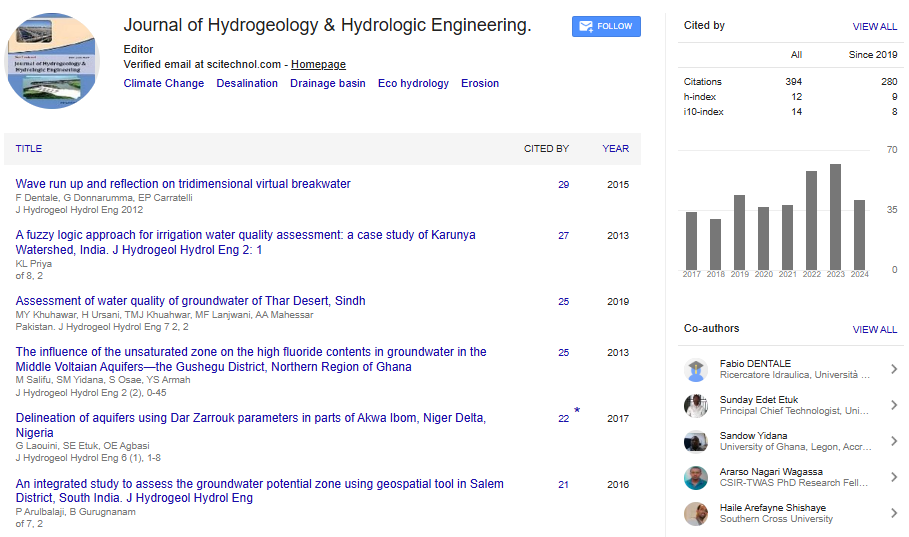Short Communication, J Hydrogeol Hydrol Eng Vol: 13 Issue: 3
The Significant Value of Effective Rain Water Management in Municipal Areas
Karina Meredith*
1Department of Civil and Environmental Science, Ohio State University, Columbus, USA
*Corresponding Author: Karina Meredith,
Department of Civil and Environmental
Science, Ohio State University, Columbus, USA
E-mail: meredithk48@gmail.com
Received date: 27 May, 2024, Manuscript No. IJMHP-24-144610;
Editor assigned date: 30 May, 2024, PreQC No. IJMHP-24-144610 (PQ);
Reviewed date: 13 June, 2024, QC No. IJMHP-24-144610;
Revised date: 21 June, 2024, Manuscript No. IJMHP-24-144610 (R);
Published date: 28 June, 2024, DOI: 10.4172/2325-9647.1000330
Citation: Meredith K (2024) The Significant Value of Effective Rain Water Management in Municipal Areas. J Hydrogeol Hydrol Eng 13:3.
Description
Storm water management is a precarious aspect of urban planning and environmental conservation. With the increase in urbanization and the consequent proliferation of impervious surfaces, managing storm water has become a significant challenge. Effective storm water management systems are essential to mitigate flooding, reduce water pollution, and protect ecosystems. This article explores the importance of storm water management, its challenges, and the innovative solutions being implemented to address these issues.
The need for storm water management
Urban areas are characterized by a high density of buildings, roads, and other impervious surfaces that prevent natural infiltration of rainwater into the ground. Instead, storm water runoff is generated, which can lead to several problems:
Flooding: Heavy rainfall can overwhelm drainage systems, causing streets, homes, and businesses to flood. This not only leads to property damage but also poses risks to human safety.
Water pollution: Runoff can pick up pollutants such as oil, chemicals, and debris from urban surfaces, carrying them into water bodies. This contamination can harm aquatic life and degrade water quality [1].
Erosion: Increased runoff can lead to soil erosion, damaging landscapes and infrastructure, and contributing to sedimentation in waterways [2].
Challenges in storm water management
Effective storm water management faces numerous challenges, including:
Aging infrastructure: Many cities have outdated drainage systems that were not designed to handle current or projected future storm water volumes.
Climate change: Changes in weather patterns, including more frequent and intense storms, are exacerbating storm water management issues [3].
Urbanization: Continued development leads to more impervious surfaces, increasing runoff and the strain on existing systems.
Regulatory and funding issues: Developing and maintaining storm water infrastructure requires significant investment, and regulatory frameworks can sometimes lag behind the emerging needs and technologies [4].
Innovative solutions
To address these challenges, a variety of innovative storm water management solutions are being implemented:
Green infrastructure: Incorporating natural elements such as green roofs, rain gardens, and permeable pavements helps absorb and filter storm water, reducing runoff and improving water quality.
Retention and detention systems: Constructing ponds, wetlands, and underground storage facilities to temporarily hold storm water can reduce peak flows and prevent flooding.
Storm water harvesting: Collecting and reusing storm water for irrigation and other non-potable uses can alleviate pressure on municipal water supplies and reduce runoff.
Smart technology: Implementing sensors and real-time monitoring systems allows for more efficient and responsive management of storm water infrastructure [5].
Case studies
Several cities have successfully implemented innovative storm water management practices. For example:
Philadelphia, USA: The city's green city, clean waters program aims to reduce storm water pollution through green infrastructure projects, including green streets, parks, and urban tree planting.
Copenhagen, Denmark: Copenhagen has developed a comprehensive storm water management plan that includes cloudburst roads and parks designed to channel and store excess rainwater during heavy storms.
Singapore: Known for its holistic approach to water management, Singapore has implemented the ABC Waters Programme, which integrates storm water management with urban planning, creating aesthetically pleasing and functional spaces [6-10].
Conclusion
Effective storm water management is essential for sustainable urban development. It requires a combination of traditional engineering approaches and innovative solutions to address the complex challenges posed by urbanization and climate change. By investing in modern infrastructure and embracing green and smart technologies, cities can mitigate the adverse impacts of storm water runoff, protect water quality, and enhance urban resilience.
References
- Ashley R, Gersonius B, Digman C, Horton B, Smith B, et al. (2018) Including uncertainty in valuing blue and green infrastructure for stormwater management. Ecosyst Serv 33: 237-246.
- Bell S (2015) Renegotiating urban water. Prog Plan 96: 1-28.
- Blecken GT, Hunt WF, Al-Rubaei AM, Viklander M, Lord WG (2017) Stormwater Control Measure (SCM) maintenance considerations to ensure designed functionality. Urban Water J 14(3): 278-290.
- Brown R, Farrelly M (2009) Delivering sustainable urban water management: A review of the hurdles we face. Water Sci Technol 59(5): 839-846.
[Crossref] [GoogleScholar] [Pubmed]
- Cettner A, Ashley R, Viklander M, Nilsson K (2013) Stormwater management and urban planning: Lessons from 40 years of innovation. J Environ Plan Manag 56(6): 786-801.
- Cousins JJ, Hill D (2021) Green infrastructure, stormwater, and the financialization of municipal environmental governance. J Environ Policy Plan 23 (5): 581-598.
- Gleick PH, Palaniappan M (2010) Peak water: Conceptual and practical limits to freshwater withdrawal and use. Proc Natl Acad Sci USA 107(25): 11155-11162.
- Priscoli DJ (2004) What is public participation in water resources management and why is it important?. Water Int 29(2): 221-227.
- Cosgrove CE, Cosgrove WJ (2013) Foresight as a tool in water resource development. Development 56(4): 484-490.
- Williams M, Zalasiewicz J, Haywood A, Ellis M (2011) The Anthropocene: A new epoch of geological time. Philos Trans R Soc A 369: 835-1111.
 Spanish
Spanish  Chinese
Chinese  Russian
Russian  German
German  French
French  Japanese
Japanese  Portuguese
Portuguese  Hindi
Hindi 
